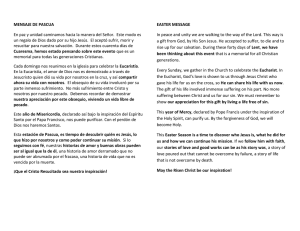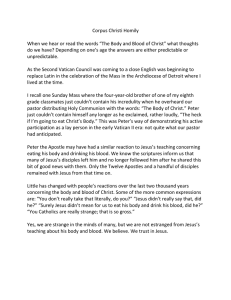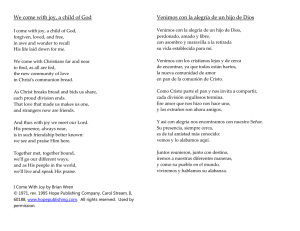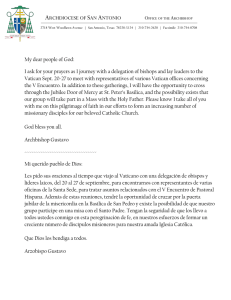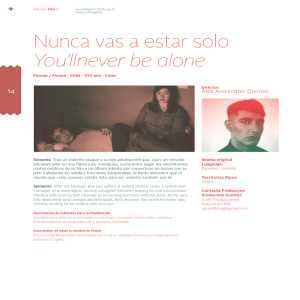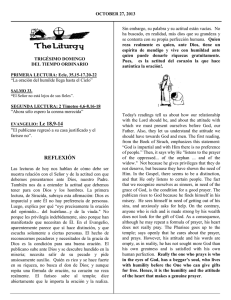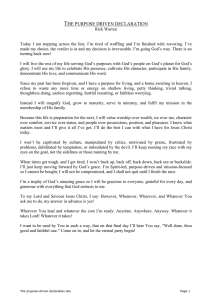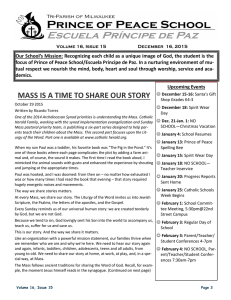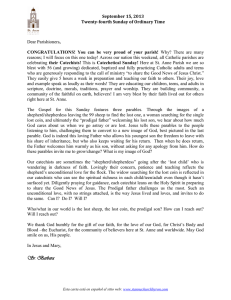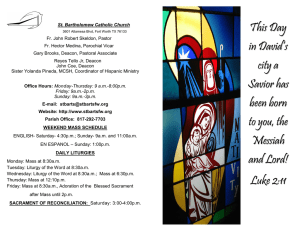From the Bulletin October 12 2014 The
Anuncio
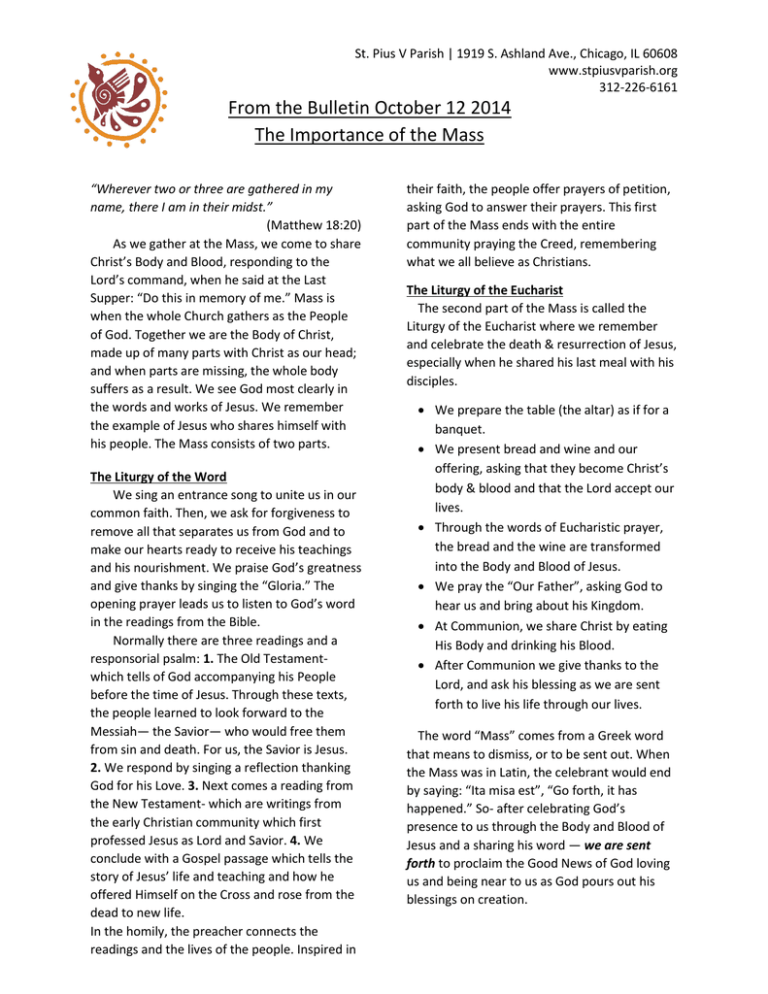
St. Pius V Parish | 1919 S. Ashland Ave., Chicago, IL 60608 www.stpiusvparish.org 312-226-6161 From the Bulletin October 12 2014 The Importance of the Mass “Wherever two or three are gathered in my name, there I am in their midst.” (Matthew 18:20) As we gather at the Mass, we come to share Christ’s Body and Blood, responding to the Lord’s command, when he said at the Last Supper: “Do this in memory of me.” Mass is when the whole Church gathers as the People of God. Together we are the Body of Christ, made up of many parts with Christ as our head; and when parts are missing, the whole body suffers as a result. We see God most clearly in the words and works of Jesus. We remember the example of Jesus who shares himself with his people. The Mass consists of two parts. The Liturgy of the Word We sing an entrance song to unite us in our common faith. Then, we ask for forgiveness to remove all that separates us from God and to make our hearts ready to receive his teachings and his nourishment. We praise God’s greatness and give thanks by singing the “Gloria.” The opening prayer leads us to listen to God’s word in the readings from the Bible. Normally there are three readings and a responsorial psalm: 1. The Old Testamentwhich tells of God accompanying his People before the time of Jesus. Through these texts, the people learned to look forward to the Messiah— the Savior— who would free them from sin and death. For us, the Savior is Jesus. 2. We respond by singing a reflection thanking God for his Love. 3. Next comes a reading from the New Testament- which are writings from the early Christian community which first professed Jesus as Lord and Savior. 4. We conclude with a Gospel passage which tells the story of Jesus’ life and teaching and how he offered Himself on the Cross and rose from the dead to new life. In the homily, the preacher connects the readings and the lives of the people. Inspired in their faith, the people offer prayers of petition, asking God to answer their prayers. This first part of the Mass ends with the entire community praying the Creed, remembering what we all believe as Christians. The Liturgy of the Eucharist The second part of the Mass is called the Liturgy of the Eucharist where we remember and celebrate the death & resurrection of Jesus, especially when he shared his last meal with his disciples. We prepare the table (the altar) as if for a banquet. We present bread and wine and our offering, asking that they become Christ’s body & blood and that the Lord accept our lives. Through the words of Eucharistic prayer, the bread and the wine are transformed into the Body and Blood of Jesus. We pray the “Our Father”, asking God to hear us and bring about his Kingdom. At Communion, we share Christ by eating His Body and drinking his Blood. After Communion we give thanks to the Lord, and ask his blessing as we are sent forth to live his life through our lives. The word “Mass” comes from a Greek word that means to dismiss, or to be sent out. When the Mass was in Latin, the celebrant would end by saying: “Ita misa est”, “Go forth, it has happened.” So- after celebrating God’s presence to us through the Body and Blood of Jesus and a sharing his word — we are sent forth to proclaim the Good News of God loving us and being near to us as God pours out his blessings on creation. St. Pius V Parish | 1919 S. Ashland Ave., Chicago, IL 60608 www.stpiusvparish.org 312-226-6161 Del Boletín de 12 Octubre 2014 La Importancia de la Misa “Donde dos o tres se reunen en mi nombre, estoy Yo en medio de ellos.” —Mattías 18, 20 Hoy nos reunimos para compartir el Cuerpo y Sangre del Señor, y responder a su madato cuando dijo en la última cena: “Hagan esto en memoria mía.” La Misa es cuando toda la Iglesia se reune como el Pueblo de Dios. S la oración de la Iglesia como el cuerpo de Cristo- con muchas partes y con Cristo como la cabeza. Cuando faltan unos miembros, todo el cuerpo sufre. Vemos a Dios claramente en las palabras y obras de Jesucristo. Recordamos su ejemplo, al que se comparta a si mismo con su pueblo. La Misa consiste en dos partes: La litúrgia de la Palabra Cantamos una canción de entrada para unirnos en la fe. Después pedimos perdón para quitar todo lo que nos separe de Dios, y preparar nuestros corazones para recibir sus enseñanzas y el alimento de su Cuerpo y Sangre. Continuamos alabando a Dios por su grandeza y dándole gracias cantando la “Gloria.” La oración iniciál nos prepara escuchar la palabra de Dios en las lecturas de la Biblia. Normalmente hay tres lecturas y un salmo responsorial: 1. Lectura del Antiguo Testamento—que habla del acompañamiento de Dios a su pueblo antes del tiempo de Jesús. Por estos textos, el Pueblo de Dios aprendía esperar un Mesías- quién vendría para librarles del pecado y de la muerte. Para nosotros el Mesías es Jesucristo. 2. Respondemos cantando una reflección dando gracias a Dios por su gran amor. 3. Después hay una lectura del Nuevo Testamento- escritos de la primera comunidad Cristiana que profesaba Jesucristo como Señor y Salvador. 4. Concluimos las lecturas con un texto del Evangelio que cuenta la vida y enseñanzas de Jesús y como se ofreció en la Cruz y resucitó de la muerte a una vida nueva. En la homilía, el predicador relaciona las lecturas con la realidad de la congregación. Inspirados en su fe, la gente ofrece peticiones, pidiendo que Dios responda a sus oraciones. The primera parte de la Misa termina con el Credo, un resumen de lo que toda la comunidad cree como cristianos. La Liturgia de la Eucaristía La segunda parte de la Misa se llama la liturgia de la eucaristía, en lo cual recordamos y celebramos la muerte y resurección de Jesús, especialmente cuando compartió la última cena con sus discípulos. • Preparamos la mesa (el altar) como por un banquete. • Presentamos pan y vino, pidiendo que lleguen a ser el Cuerpo y Sangre de Cristo, y que el Señor acepte la ofrenda de nuestras vidas. • Por la plegaria eucharistica, el pan y el vino se transformanen le Cuerpo y Sangre de Cristo. • Rezamos el “Padre Nuestro” pidiendo que Dios nos escuche y realice su Reino. • En la Comunión, Cristo nos alimenta con su Cuerpo y su Sangre. • Después de la Comunión, damos gracias al Señor, y le pedimos su bendición antes de despedirnos. La palabra “Misa” viene de una palabra griega que significa despedir o estar enviado con un mensaje. Antes, el celebrante decía en Latín: “Ita misa est.” es decir: “Váyanse, se ha pasado.” Así es- después de la celebración de la presencia de Dios en Jesucristo por su Cuerpo y Sangre y el compartir de su palabra- estamos mandados para proclamar la Buena Nueva del amor de Dios y su cercanía mientras que Dios derrame sus bendiciones por toda la creación.
